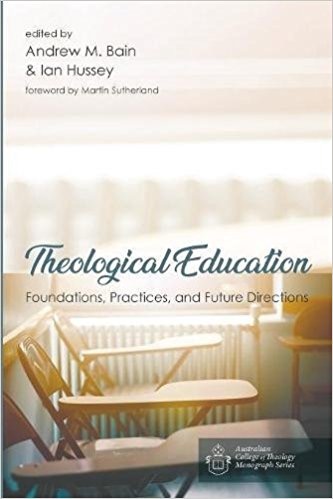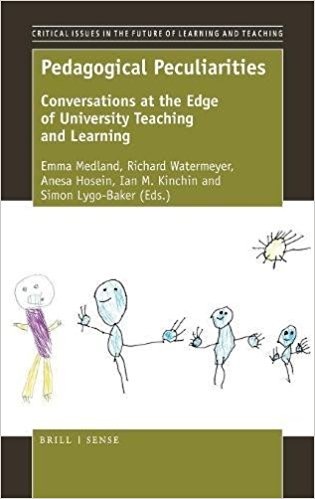pedagogy
Select an item by clicking its checkbox

Theological Education: Foundations, Practices, and Future Directions
Date Reviewed: October 1, 2018
This edited volume of 21 articles explores the biblical and theological perspectives, historical foundations, current practices, and future directions of theological education in Australia and was published as part of the Australian College of Theology Monograph Series. The authors represent a wide array of theological disciplines including church history, Old Testament, New Testament, pastoral studies, Christian education, evangelism, spirituality, and theology. In addition to their academic disciplines, the authors come from a variety of backgrounds including adjunct faculty, faculty, administrators from academic intuitions and from the Australian and New Zealand Association of Theological Schools, as well as pastors mainly from evangelical perspectives.
Building upon the concept that the church follows where theological education leads, the editors of this volume, Bain and Hussey, argue in their introduction that “theological education is too important a task to be done without careful and ongoing thought. The imperative to be reflective about how we go about our task as theological educator is amplified dramatically by the changing world in which we live” (xix). This volume attempts to survey this current reflection on theological education in the Australian context.
The first section of this volume, Biblical and Theological Perspectives, offers three chapters that explore how the ontological view of the centers of theological education impact their praxis. These three chapters represent one of the most insightful parts of this book as the three authors all successfully explore how theological assumptions and perspectives shape how theological education has and is happening in Australia. Barker explains “I offer my reflections on how an evangelical understanding of what we are teaching should shape how we teach it” (4). Many of these same concepts emerge in Starling’s article, “The Scribe, the Steward, and the Inhabiting Word,” where Starling asks how these three metaphors “inform the way in which we seek to shape the curriculum for theological education in our own time and the institutions within which we teach it?” (25).
In the second section, Historical Perspectives, six articles explore the historical foundations of theological education in Australia. These chapters examine a variety of themes including theological education in early Christianity, models of western theological education, the impact of American theological education (especially the recently closed Andover Theological seminary), as well as Australian specific chapters with histories of the Australian College of Theology and Sydney Missionary and Bible College.
The third and largest section of this book, Current Practices, provides nine articles that examine a variety of current perspectives and groups within Australian theological education including: women, the Chinese immigrants, missional approaches, spiritual formation, attrition, cross-culture ministry, and an empirical exploration of who is currently engaged in theological education.
The final section, Future Directions, offers three articles that explore future directions of theological education in the Australian context. Although these three authors provide solid chapters on telecommuting staff and challenges for theological education, this is the weakest section of this volume. After providing a broad foundation with historical perspective and current practices, the future directions lack the visionary perspectives of the rest of the book. It would have been wonderful if this section could have been expanded to examine many of the challenges identified in the Current Practices section.
This title provides a valuable piece to the puzzle of theological education around the globe. Theological education is a complex endeavor and through the contextualization of various methods and historical models to it, the challenge of theological education can be addressed with wit and wisdom. This is an important volume and should be added to the collection of major theological libraries and institutions that explore the history of religion and/or approaches to theological education.

Pedagogical Peculiarities: Conversations at the Edge of University Teaching and Learning (Critical Issues in the Future of Learning and Teaching)
Date Reviewed: September 14, 2018
This edited volume (its authors primarily situated in England) offers a resource for those in higher education who face a rapidly changing educational landscape often marked by “increased marketization and bureaucracy” (ix). In looking at the peculiar distinctions of university pedagogy, this resource reconsiders the traditional academic tripartite roles of researcher, teacher, and administrator in light of growing challenges facing post-secondary educators today and especially in theological education and religious studies. These challenges include the increasing separation of these three academic roles from one another, the redefining of excellent teaching mostly in terms of assessment and evaluation, and finally, the reduction of teaching to a simple series of techniques and best practices.
Pedagogical Peculiarities resists these trends through “deliberative dialogues” (xi) that reflectively peer into a wide swath of disciplines, university roles, and issues. In the first chapter, Stephen D. Brookfield raises two different kinds of peculiarities in university teaching. First, by teaching, educators simultaneously offer seemingly factual and neutral content amidst complex, and at times, competing internal opinions that stem from the multilayered structures of teaching. Thus, teaching is not so clean a process and is far more multifaceted than the passing on of content alone. A second peculiarity, “the contextuality of practice,” involves teaching plans that despite being mostly crafted in an educator’s solitude and internal space, experience a metamorphosis when they externally reach a student. Grand plans are adjusted and the deft teacher is left to alter plans “on the fly” (2). In the concluding chapter, “Building an Agenda for Academic Development on the Peculiarity of University Teaching,” Paul Ashwin reflects upon tensions that exist when thinking about university academic development. These tensions are between: (1) teaching as an individual and as a collective activity, (2) the local and the global in teaching, (3) complexity and simplification, (4) the practical and theoretical, (5) ideas of what it means to be an academic, (6) excellence and enhancement, and (7) the radical potential of university teaching and the tendency for conformity in university teaching (115-22). The opening and concluding chapters bookend three sections subdivided into three pedagogical identities: (1) Identity as it relates to teaching (chapters two and three); (2) Identity as it relates to the discipline (chapters four and five); and (3) Identity as it relates to the institution (chapters six and seven). The middle chapters probe Ashwin’s seven tensions through a variety of disciplines with hope of a better understanding of pedagogy and teaching.
The book’s methodology, which includes dialogue, interview, case study, illustrations, and narrative, is a welcomed variation from resources written in prose. The cultural differences between a U.S.-based reviewer and a primarily U.K.-based text were apparent, but were easily clarified. Overall, this text raises important pedagogical issues for university deans, chairs, and academic development administrators. It also spurs conversations for current or aspiring academics who are rethinking their identity as teacher-scholars amidst shifting needs in higher education.
Over the past few months, the entries in this blog series have attempted to provide guidance and insight related to the pedagogical challenges of teaching traumatic materials. The series was initiated to provide a sense of reassurance about facing these challenges. By discussing the range of challenges, the variety of ...
Over the past several years, there have been any number of events that have prompted professors to abandon their syllabi and lesson plans and create space for addressing events unfolding outside the walls of the classroom. This in-breaking of the contemporary, this pressure of the immediate, is often traumatic in ...

Education Is Not an App: The Future of University Teaching in the Internet Age
Date Reviewed: March 23, 2018
This book captures the frustration of many faculty who are witnessing the decline of faculty governance against the rise of administrative fiat, particularly in areas that impact pedagogical choice. In seven main chapters, the authors provide a detailed view of the systems and decisions that are so often thrust upon faculty. They do a superb job describing the landscape of MOOCs, FLOSS, and LMS in everyday language. They deal with a broad range of issues to show the ways in which faculty are being (sometimes willingly) deskilled through technology. These authors are not dismissive of technological innovation, but they are wary of some aspects of it. They are aware that this book will quickly become outdated but teachers will find that the evidence and core arguments presented here remain worthy of attention.
Education is Not an App is a manifesto of sorts, calling faculty to embrace their freedom to make pedagogical choices, a freedom that is often smothered by administrative decree. For instance, the authors argue, new learning management systems are often presented to faculty as across-the-board, time-saving solutions for all, not as the political flashpoints they should be. For these authors, educational technology tends to “seek constrained truth for the advantage of specific powers that be” (3), just as the simplest app constrains as it empowers.
Several key assumptions and at least one conclusion here might irk some readers. First is the assumption that face-to-face education is superior to online education, with very limited exceptions. The authors assert that the work that happens between people in classrooms produces more critical thinking, and therefore more meaningful learning than most experiences online. This reader agrees, but not all will. Another assumption is that faculty will have the ability (or the interest) to keep current with new technologies and will have institutional support in using the ones they choose, a lofty goal on both counts. Few faculty have the time to school themselves on emerging technologies, and pressures such as student evaluations reward conformity. These authors conclude, quite rightly, that faculty jobs are in danger because of the “the kind of university governance that makes this kind of [edtech] abuse possible” (37). This book highlights many issues that raise concern (not least, the rise of “instructional designers”), but we do not yet know that student learning suffers in this tech-heavy environment. The authors focus more on academic freedom and far less on student learning.
Poritz and Rees are correct that educational technology – with its unbundling and deskilling and administrative oversight – threatens academic freedom and the autonomy of thought we hope to teach our students. It invites monitoring and assessment that faculty should resist; at the very least, teachers should consider at length the costs of simplifying their teaching lives through technology. “At the risk of sounding alarmist” (74), faculty in all disciplines should read this book. Even those who resist as much as possible should be aware of the changing landscape. We gain and lose in the decisions that we make, but we stand to lose more from decisions made for us.
